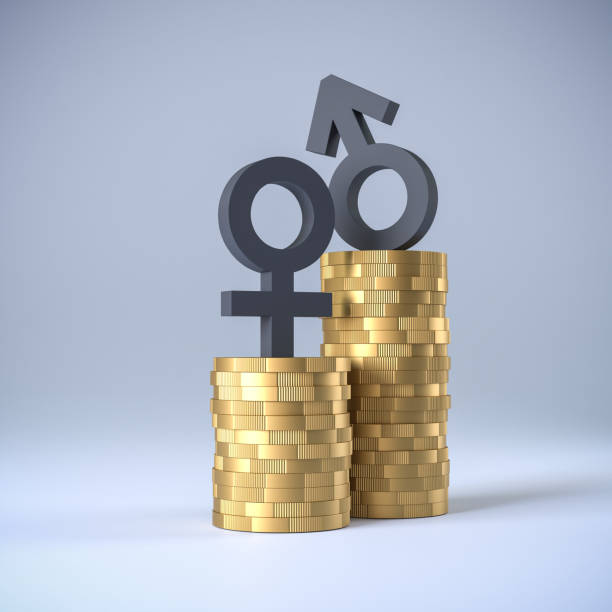Last Updated on January 16, 2023

We have previously examined the meaning of the gender pay gap and its history. We also spoke about countries that foster the pay gap and countries that fight it.
The gender pay gap refers to the difference in median earnings between men and women. According to data from the US Bureau of Labor Statistics, in 2019, the median weekly earnings for women were $789, or 82% of men’s median weekly earnings of $962. The gap varies by race, with white women earning 78% of white men’s earnings, black women earning 90% of black men’s earnings, and Hispanic women earning 89% of Hispanic men’s earnings. Women are also underrepresented in higher-paying occupations and overrepresented in lower-paying occupations. Factors that contribute to the gap include discrimination, the disproportionate share of caregiving responsibilities borne by women, and a lack of affordable child care. Efforts to close the gap include implementing equal pay laws, increasing the minimum wage, and promoting workplace flexibility.
So this article will be focusing on the existence of the gender pay gap in some industries. Is it true or not? We will be working with industries that are rumored to have a welcoming environment for both genders, even if there is a shortage of one of each gender in these industries.
The industries we will be working with are the Nursing Industry and Tech Industry.
The Gender Pay Gap In Nursing
The nursing industry is a critical component of the healthcare system, providing direct care to patients and working closely with other healthcare professionals to ensure the well-being of individuals and communities. Nurses work in a variety of settings, including hospitals, clinics, long-term care facilities, schools, and patient’s homes.
There are several different types of nurses, each with its specific roles and responsibilities. Registered nurses (RNs) are the largest group of nurses and have completed a nursing program and passed a national licensing exam. They are responsible for assessing patients’ health needs, developing and implementing care plans, administering medication, and educating patients and their families about their health conditions.
Licensed practical nurses (LPNs) and licensed vocational nurses (LVNs) have completed a shorter educational program and have a more limited scope of practice than RNs. They typically work under the supervision of RNs or physicians and assist with basic patient care tasks such as taking vital signs, administering medication, and providing basic wound care.
Advanced practice nurses (APNs) are RNs who have completed advanced education and training. They include nurse practitioners (NPs), clinical nurse specialists (CNSs), and nurse anesthetists (CRNAs). APNs can provide a wide range of primary, acute, and specialty care services, and in some states, they are authorized to practice independently.
The nursing industry is projected to grow rapidly in the coming years, driven by an aging population, an increased focus on preventative care, and a growing shortage of healthcare professionals. However, the nursing industry is facing several challenges, including burnout among nurses, a gender pay gap, a lack of diversity and representation in the workforce, and a shortage of qualified nurses to meet the increasing demand for healthcare services.
Statistics and data on the gender pay gap within the nursing industry
Since the commencement of the Equal Pay Act 50 years ago, as it has been dubbed in many countries across the world, the salary divide between men and women has been steadily narrowing across many occupations.
Yet, surprising research published in the Journal of the American Medical Association indicates that in a female-dominated profession such as nursing, women continue to make less than their male colleagues.
Using data from two surveys spanning 25 years, researchers found that among approximately 300,000 registered nurses:
(RN), a male RN, on average, earns $5,100 more than a female RN in a similar role. Factors such as working hours, experience, marital status, and clinical specialization can influence salaries, but gender differences were apparent even after considering these variables. Wage inequality has changed little since 1988.
These findings are troubling given that men only make up about 6% of nurses in the US. Despite the overwhelming presence of women in nursing, male nurses outperform female nurses in almost all environments and subject areas, including:
• At the hospital, the man outnumbered the woman by $3,783.
• At the outpatient facility, the difference was $7,678.
• The narrowest wage gap was in chronic disease care.
$3,792.
• The largest salary differences were among anesthesiologists:
$17,290.
Analysis of the factors contributing to the wage disparity
The gender pay gap in the nursing industry is a complex issue that is influenced by a variety of factors.
One of the main contributing factors is the underrepresentation of women in higher-paying and higher-level positions. For example, men are more likely to be in leadership roles such as department heads or administrators, which typically come with higher salaries than front-line nursing positions. Additionally, men are more likely to pursue advanced education and certifications, which can lead to higher pay. The percentage of women who ask and demand higher pay and decide to pursue advanced learning is nowhere near their male counterparts.
Another factor is discrimination and bias, which can lead to women being overlooked for promotions or not being paid as much as men for the same job. Studies have shown that women are often perceived as less competent or less committed to their careers than men, which can lead to them being passed over for leadership roles or high-paying positions.
Additionally, occupational segregation is also a contributing factor, where men tend to work in higher-paying specialties such as emergency and critical care while women tend to work in lower-paying specialties such as geriatric care and pediatrics.
Finally, there is also a lack of transparency in the industry when it comes to paying, which makes it difficult for women to know if they are being paid fairly and also hampers their ability to negotiate for higher pay.
Overall, the gender pay gap in the nursing industry is influenced by a complex interplay of factors, including underrepresentation in higher-paying positions, discrimination and bias, occupational segregation, and a lack of transparency in the industry.
How to close the gender pay gap
Closing the gender pay gap in the nursing industry can be achieved through a variety of strategies, including:
- Conducting regular pay equity audits to identify and address any discrepancies in pay between male and female nurses
- Providing equal pay for equal work, regardless of gender.
- Offering training and development opportunities for female nurses to help them advance in their careers and increase their earning potential. If it is not offered, female nurses should look for it either way.
- Female nurses need to negotiate for better pay and benefits. Always negotiate and don’t be afraid of turning a job down.
- Promoting more women to leadership positions within the nursing industry. Women need to go for leadership positions as soon as they know their experience and good work matches up to it. Don’t hold back and if you are sidelined, speak up and learn to look for opportunities in places that will appreciate you more.
- Providing flexible work options to accommodate the needs of working mothers and caregivers. As done in the UK and Iceland
- Increasing transparency around pay scales and compensation packages to ensure fairness and equity.
- Encourage the nursing profession to be a profession with fair remuneration and benefits.
- Organizations should conduct studies to understand the impact of gender on the nursing profession.
- Support policies that promote fair pay and support working mothers and caregivers.
It’s important to note that closing the gender pay gap is a complex issue that requires ongoing effort, collaboration, and commitment from employers, employees, and policymakers.
Case studies of Companies who have Worked to Close the Gender Pay Gap In Tech
It’s no secret that the tech industry suffers from diversity issues. The issue extends to all levels of the company, from compensation for women and minority workers to representation at all levels of the workforce. However, a tipping point has occurred as more and more companies are paying attention to and starting to address this issue.
Many companies are taking steps to address the gender gap issue. In some cases, such as with tech giant Google, efforts have fallen short. However, in other cases, the changes made have made significant progress in addressing the gender gap. Here are some companies that have recently gained a foothold in this space and how they did it.
1. Duolingo
Duolingo CEO and co-founder Luis von Ahn took to Twitter in October to highlight the company’s 50:50 ratio. The ratio of new graduate software engineers. Surprisingly, and perhaps unsurprisingly, the reaction the company received was, as von Ahn put it, from “a man who angrily argued against discrimination and insisted that the best people should be hired instead.”
The co-founder criticized the idea that promoting diversity somehow reduces quality. “They have an excellent GPA, received excellent endorsements, and passed our very thorough application process with flying colors.”
Duolingo celebrates its 50:50 ratio with a multifaceted, data-driven approach. We recruited only women enrolled in computer science programs from universities above the national average (18%), including Duke, Cornell, Harvard, and the Massachusetts Institute of Technology. After that, I contacted the women’s groups at each school and attended all the networking events that were held. sponsored her Grace Hopper conference in 2017, open to all female engineers. Finally, Duolingo states that it exposed all interviewers to an unconscious bias in their training.
Through its internal and external activities, Duolingo demonstrates its ongoing commitment to promoting diversity and gender equality in the workplace.
2. Salesforce
Since Salesforce began investigating pay gaps in 2016, it has spent $6 million to close the gap.
This action aligns with a promise made by Salesforce CEO Marc Benioff in his 2015 interview with HuffPost. “My job is to make sure women are 100 percent equal in terms of pay, opportunities, and promotions at Salesforce,” Benioff said, noting what the gender pay gap looked like at the time. I didn’t know; I knew, but I said I made up my mind. Find out and act accordingly.
Salesforce is committed to implementing regular pay reviews, reflecting the fact that equal pay is a “moving target,” as its vice president of global employee success, Cindy Robbins, said. I’m in.
3. Bloomberg
In March 2018, Bloomberg Editor-in-Chief John Micklethwait announced a new staff policy on speaking outside the company. To promote gender equality in and out of the newsroom, each panel must have at least one woman on it for a Bloomberg journalist to participate. “To put it bluntly, that woman could be you,” Micklethwaite said.
If this condition is not met, the journalist has to refuse, but if a journalist feels the need to join an all-male panel, there seems to be a grievance system in place. “I think it’s a standard that should be upheld in a large number of cases,” concludes Micklethwait.
4. Nike
Nike has been the center of controversy in the gender world for a year, culminating when four women sued the sportswear company for alleged discrimination. The women allege Nike violated equal pay laws in the United States and fostered a work environment that allowed sexual harassment, The Guardian reported in August this year.
Before the lawsuit was filed, Nike responded to the issues raised by the ousting of several high-profile executives with what it called a “harassment bill.” Previously, Nike’s chief human resources officer, Monique Matheson, said in an employee memo obtained by The Wall Street Journal that the company was letting women down and wanted to “create a culture of true inclusion.” I acknowledged that we need to “improve the representation of women and people of color.” In the same month, the company announced plans to adjust the wages of its 7,000 employees following an internal salary review to close the pay gap.
Nike is probably in the early stages of overcoming that problem. These moves are more about putting out fires than creating structural changes, but they’re a great start for the shoe giant.
Best practices and recommendations for addressing the wage disparity in tech
1. Open discussion
Through open discussion, women become aware of and respond to potential pay gaps in the workplace. This can be done through an open conversation with a colleague, a chat with alumni at your company, or a chat with a member of your HR team.
2. Collaboration between business, government, and women
Business leaders are responsible for the wide pay gap between men and women in the tech industry. Both parties should be offered the same salary, regardless of gender. Governments are equally responsible for this mistreatment of women in tech and should mandate gender equality through politics. Closing the pay gap is only possible if women know their worth and no one takes credit for their accomplishments. So women have to start taking them being appreciated more over any other thing. As long as the pay gap exists, women have to be ruthless in being the best and asking for the best in return, because being the best is not enough for these biased companies. So speak up or move to places where you are treated accordingly.
3. A global program that provides visibility and resources for women in tech
Google already does this with its Women Techmakers Program. Since 2014, Women Techmakers has continuously launched global initiatives to develop new programs to empower women in IT. a platform to celebrate women’s technical genius and shine a spotlight on their role models. Additionally, the program sponsors fully funded scholarships for technical certification courses for women worldwide.
Girls Who Code, a non-profit organization, strives to support and increase women’s representation in computing. It works with a single mission: to bridge the gender gap in technology.
Hackbright Academy is another great software development program for her. Here, a woman can learn the skills she needs to become a full-time software engineer. They are on a mission to provide women with an individual path to a career as a software engineer. Additionally, over 700 alumni work at tech companies such as Google, Dropbox, and Airbnb.
Conclusion
Addressing the gender pay gap in the tech and nursing industries is crucial for achieving gender equality in the workforce. The gender pay gap is not only an economic issue; it is also a social issue that perpetuates discrimination and inequality. When women are paid less than men for the same work, it undermines their abilities and devalues their contributions. Additionally, the gender pay gap can also have a significant impact on women’s overall well-being and financial security, as well as on their families and communities.
Furthermore, addressing the gender pay gap in the tech and nursing industries is important for employers as well. A diverse and inclusive workforce is essential for driving innovation and growth, and companies with greater gender diversity tend to be more profitable. By addressing the gender pay gap, employers can attract and retain talented female employees, reduce turnover, and improve employee satisfaction and engagement.
To address the gender pay gap in the tech and nursing industries, employers need to conduct regular pay equity audits, provide equal pay for equal work, increase transparency, and provide training and development opportunities for women to advance in their careers. Additionally, policymakers need to support policies that promote fair pay and support working mothers and caregivers.
NB: The statistics and research for this article were taken from the U.S, Australia, Canada, and the U.K
Before you go…
Hey, thank you for reading this blog to the end. I hope it was helpful. Let me tell you a little bit about Nicholas Idoko Technologies. We help businesses and companies build an online presence by developing web, mobile, desktop, and blockchain applications.
We also help aspiring software developers and programmers learn the skills they need to have a successful career. Take your first step to becoming a programming boss by joining our Learn To Code academy today!
Contact us if you need more information or have any questions! We are readily available.











